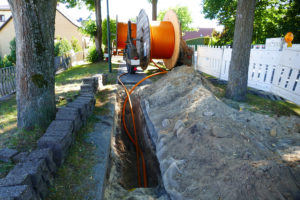
To help address California’s broadband crisis, the governor and Legislature have come together through recent budget actions to fund $6 billion in new broadband infrastructure and increased access for service. This historic investment calls for the development of a new open-access, middle-mile network to serve communities currently struggling without affordable reliable broadband service.
According to the Benton Institute for Broadband & Society, such open-access middle-mile networks provide a key means for spurring providers of broadband service to make needed “last-mile” connections to homes and businesses. The Institute’s findings are contained in a recent policy brief, “If We Build It, Will They Come: Lessons From Open-Access, Middle-Mile Networks.” The December 2020 report explains the approaches and successes of many states and communities that have deployed middle-mile networks to improve service to their residents and urges the federal government to support the construction of such networks.
The new broadband investments for California are slated to be rolled out over several years. They are included in the 2021-22 state budget, which was approved by legislators in late June and is now before the Governor for his signature. The broadband investments will be covered through a combination of federal American Rescue Plan Act and state funds, with many implementing details yet to be worked out.
As the Benton report explains, middle-mile networks reach out from national or major regional internet backbones to local connection sites, such as schools, libraries, and residential customers. Open-access “means the network permits any broadband provider to connect to the network on nondiscriminatory terms and conditions.”
This is distinct from middle-mile networks owned by private providers, which often do not permit other providers to deploy from such networks to provide “last-mile” service to residences and businesses or charge prohibitive rates. “[L]imited competition,” the report notes, “is typically associated with harm to consumers in the form of higher prices, lower quality, slower innovation, reduced customer service, or some combination thereof.”
By developing and operating open-access middle-mile networks, governments in other states and communities have been able to provide the capital cost savings and opportunities that catalyze other broadband providers to enter the market and serve customers. Supporting competition in this manner can ultimately help bring service to areas where broadband is scarce, including rural areas, and lead to more competitive pricing options for residents and business customers.
The report describes a number of approaches, strategies, and outcomes related to development of open-access, middle-mile networks throughout the nation, including in Ohio, Virginia, Illinois, Utah, Maine, Colorado, Massachusetts, Minnesota, Washington, Indiana, Arizona, and New Mexico.
Earlier this year, the California Forward Action Fund joined other key partners in advocating for broadband investments of the scale and nature now embraced by the governor and Legislature. These investments will help make affordable, reliable high-speed internet available to all Californians, in direct alignment with the principles of the California Economic Summit.

